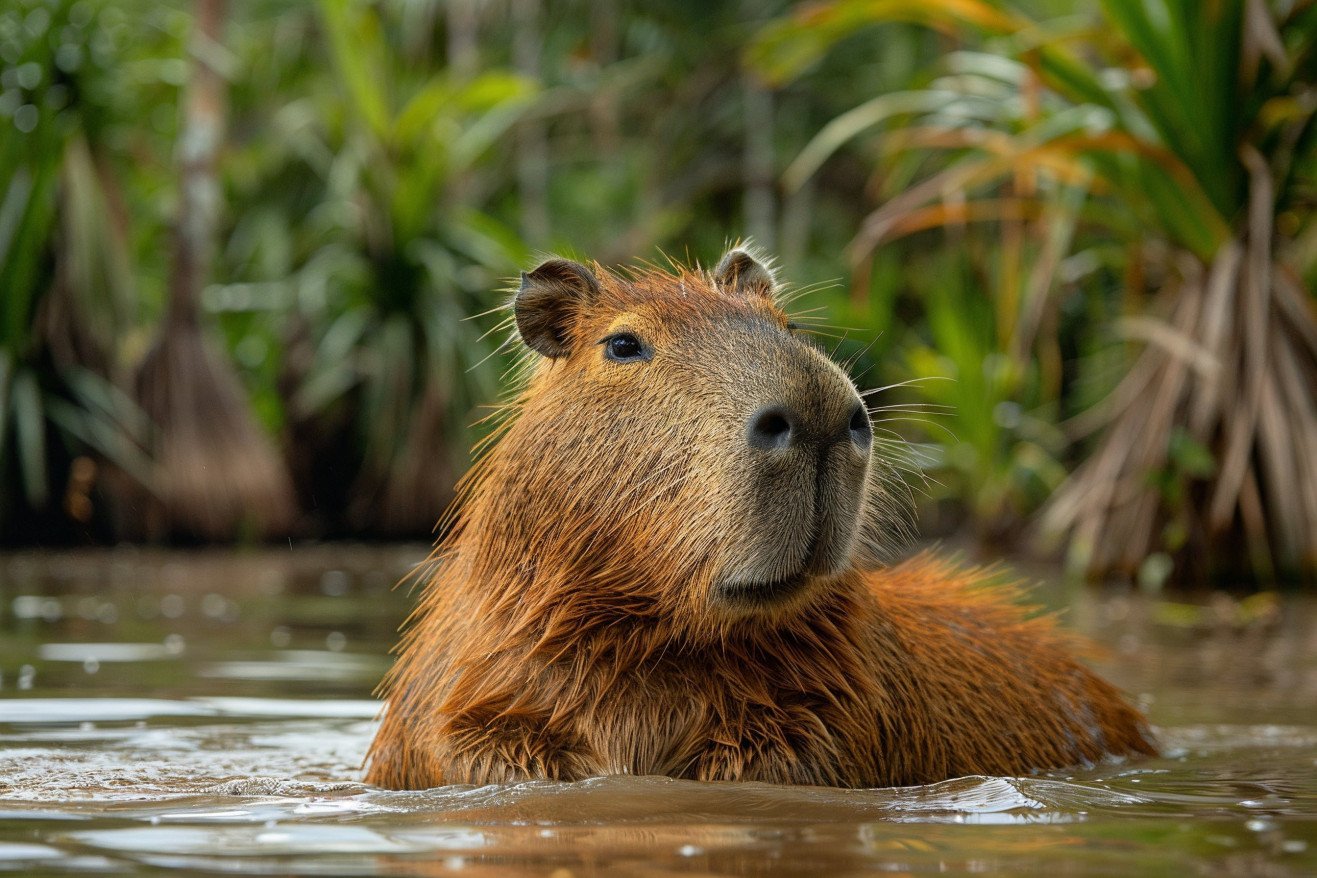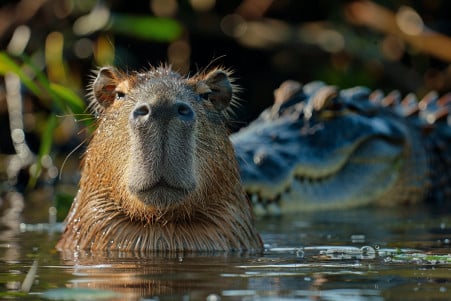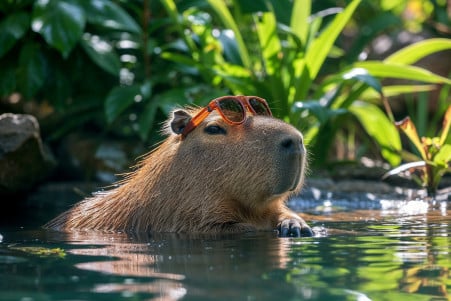Can Capybaras Be Dangerous? What the Experts Say
1 May 2024 • Updated 30 April 2024

Despite their resemblance to giant guinea pigs, capybaras are not like the sweet, cuddly pets many of us have had in our homes. Capybaras are the world's largest living rodents and are found in South America. They can weigh up to 145 lbs (66 kg) and are semi-aquatic creatures. While they are generally shy and non-aggressive around people, they have large, sharp teeth and strong jaws that can cause significant harm when they feel threatened or are protecting their offspring.
To help you better understand the potential dangers of capybaras, we'll look at studies by wildlife biologists, zoo professionals, and anecdotal evidence that discusses their defensive tendencies and interactions with humans. This will help you learn how to assess the risks and enjoy these fascinating animals while keeping yourself safe and maintaining a respectful distance. Armed with this knowledge, you can make informed decisions when you come across capybaras in the wild or in a zoo or other animal facility.
Can Capybaras Be Dangerous?
Capybara Social Structure and Interactions
Capybaras are social animals that live in groups called herds, especially during the dry season when they congregate around water holes, according to the International Environment Library Consortium. The herd is organized in a dominance hierarchy that includes the dominant male, subordinate males, females, and their offspring. The dominant male, which is usually the largest, has priority access to resources such as water holes and mating opportunities.
Capybaras use vocalizations, grooming, and scent marking to maintain their social relationships. They are also very vocal animals, using a variety of sounds, including chirps, whistles, purrs, huffs, and even barks to communicate with other members of their herd. Capybaras are territorial, and males, especially the dominant male, may show aggression by barking at, chasing, or biting subordinates, especially on the rump.
Capybaras have a symbiotic relationship with certain bird species, including cattle tyrants and caracaras, that use them as a lookout post to find prey, according to the Environment Library Consortium. In the wild, capybaras, which are the largest living rodents, have a lifespan of 5-7 years and can weigh up to 145 lbs (66 kg) for males.
Although capybaras are generally tolerant of humans, their social structure and the potential for male aggression mean that it's important to observe them from a distance, which leads us to the next section, where we'll talk about their habitat and conservation.
Capybara Habitats and Conservation Status
Capybaras can be found all over South and Central America, with the common capybara (Hydrochoerus hydrochaeris) having a large, continuous range that spans Venezuela, Colombia, the Guianas, Brazil, Paraguay, Uruguay, and northeastern Argentina, according to the International Environment Library Consortium. On the other hand, the lesser capybara (Hydrochoerus isthmius) has a much smaller range that includes eastern Panama, northern coastal Colombia, and Venezuela.
These semiaquatic rodents live in swampy grasslands near rivers, lakes, and other bodies of water, per PBS Nature. Unfortunately, they are threatened by deforestation, habitat destruction, and illegal hunting, according to Wikipedia. While the greater capybara is listed as of Least Concern by the IUCN's Red List, the lesser capybara species is listed as Data Deficient, according to Green Matters.
In a twist, capybara farming in some areas has actually helped protect the wetlands where they live, which shows just how complicated the relationship between humans and these animals can be. As we've seen in the potential dangers and benefits of human interaction with capybaras, responsible observation and conservation are the best ways to ensure that these animals will be around for a long time to come.
Capybaras in Captivity and Human Interactions
Capybaras are not recommended as pets due to the many challenges of keeping them, which are detailed in The Spruce Pets. Despite the fact that they are often referred to as "giant guinea pigs", the care and environmental requirements of capybaras mean they are not well-suited to most homes. These large rodents, which can weigh up to 170 pounds, need to be kept in spacious, wetland habitats with deep water for swimming and cooling. Their diet is also very specific, consisting of high-quality grass hay, guinea pig pellets, and a limited selection of other plants.
While some capybaras in captivity have been known to bond with their human keepers, as noted in Capybara World, these highly social animals are best left to live in the wild or in professional settings where their many needs can be met. In addition, both PubMed and The Journal of Emergency Medicine have documented cases of capybaras biting people and causing severe injuries due to their powerful jaws and sharp teeth when they feel threatened. It is important to observe capybaras responsibly and from a safe distance to prevent injury and ensure their well-being.
Capybara Predators and How Capybaras Defend Themselves
Capybaras are hunted by a number of predators in the wild. The most common predators are large cats, such as jaguars (Panthera onca) and pumas (Puma concolor), according to Capybara Facts. Jaguars are known to stalk capybaras and then pounce on them from behind, using their sharp claws to break the capybara’s neck and kill it instantly, according to Capybara Predators. Pumas are also known to hunt capybaras and use their speed and agility to catch them.
In the water, capybaras are hunted by caimans, a type of alligator native to South America, according to the Rainforest Alliance. Snakes, such as boa constrictors and pythons, are also known to prey on capybaras, especially young ones, which they can kill with a single bite, according to Capybara Predators.
Capybaras have a number of ways to defend themselves against these predators. When threatened, capybaras will immediately run into the water and stay submerged for up to five minutes to avoid detection, according to the Rainforest Alliance. Capybaras also use their large size, sharp teeth, and group living to fend off and protect themselves from predators, according to Discover Wildlife. That said, young capybaras are still at risk from a number of predators.
Knowing what capybaras are up against and how they've evolved to deal with these challenges is important for anyone who wants to observe these interesting animals in the wild, as we'll see in the next section.
How to Safely Watch Capybaras
If you're lucky enough to see capybaras in the wild, it's important to keep a safe distance. According to Are Capybaras Dangerous - Capybara, capybaras can be territorial and are known to bite humans if they feel threatened, especially if they are protecting their babies or during mating season. Therefore, it's important not to approach capybaras or try to feed them, which can lead to aggression.
To recognize signs of aggression, Capybara Facts suggests looking for behaviors like growling, standing their ground, and not retreating. The best way to watch capybaras is from a distance with binoculars or by visiting reputable facilities where they are well-cared for, as noted by Discover Wildlife.
Even though capybaras are often described as gentle, it's important to practice ethical wildlife viewing for the safety of both people and animals. By observing capybaras from a distance, we can enjoy their interesting behaviors and help ensure that their populations are protected through conservation.
Conclusion: Appreciating the Gentle Giants of the Rodent World
Capybaras are generally docile and non-aggressive animals that only attack when provoked or threatened. They are highly social animals that live in groups and are known for their playful and vocal nature, often grunting, whistling, and squealing.
Capybaras are also intelligent animals that experience a range of emotions, and they can even suffer from depression if they are separated from their social group for too long. They are semiaquatic animals that are well-adapted to an aquatic lifestyle, with webbed feet that help them move through the water with ease. They often use water to escape from predators and to help them cool off.
While capybaras are not aggressive, they can be territorial, especially the males, and they can be aggressive if they feel their young are threatened. They are also capable of causing serious harm due to their size and powerful jaws, so it is important to keep a safe distance from them.


